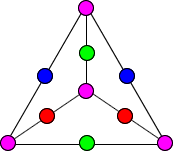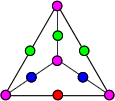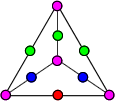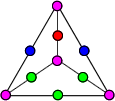Hadrons
Now that we’ve thought about how one quark might be converted into another, via W bosons, in terms of S|T triplets (actually, I didn’t mention the W+ boson conversion, because it’s the same, only in a different direction), we ought to go ahead and ruminate a little bit about combinations of quarks in terms of S|T triplets. Such combinations are called hadrons and the hadrons, belonging to the first generation fermions of the standard model (SM), are the familiar proton and neutron, the only stable hadrons known.
Curiously, however, the free neutron is not stable, but undergoes beta decay in about 15 minutes, outside the atomic nucleus (see previous post below). Not only this, but the quarks are never observed outside the hadrons either, but are “confined” to their bound state that constitutes the hadron. Nobody knows why this is so yet, but the observation is that the energy required to separate the quarks of a hadron exceeds the energy to produce a new quark|antiquark pair (meson). Yet, evidently, the quarks are “free to move inside” the hadron (i.e they have properties of motion, such as force, momentum, etc.), even though the “force” that binds them together becomes very strong if one attempts to separate them. This is called “asymptotic freedom” and it is part of the LST community’s quantum chromodynamics (QCD) theory for the SM.
In QCD, two up quarks and a down quark constitute a proton hadron, while two down quarks and an up quark constitute a neutron hadron. In terms of S|T triplets, these two combinations of the three quarks can take the form of a double tetrahedron, where the three nodes (ABC) of one S|T triplet each become combinations of the four SUDR - TUDR components of four SIT units, while the two opposed nodes in the third dimension are combinations of three SUDR - TUDR components, forming the two apexes of the double tetrahedron. The illustration in figure 1 shows the general idea of a double tetrahedron.

 +
+  =
= 
Figure 1. Two Tetrahedra Combined as One Double Tetrahedron
In our S|T combinations, the first tetrahedron is formed when a base S|T triplet is combined with its inverse, where the inverse is formed by splitting one end of a W- boson and joining the three separated magnitudes to the ABC vertices of the base triplet. Then the same process, repeated with a W+ boson, on the opposite side of the base triplet, forms the double tetrahedron. However, it has to be stressed, again, that these are geometric analogs of motion magnitudes, at this point. There is no distance, or spatial length, involved in these combinations of magnitudes of motion, other than the numerical “distance” between magnitudes of opposite “direction.” Therefore, physically, these S|T combinations constitute one expanding/contracting sphere of unit radius, with superimposed combinations of space|time magnitudes, depicted by the geometric magnitudes.
Moreover, even though a geometric tetrahedron is so called, because it is a figure of four surfaces, and, therefore, the double tetrahedron is a figure of eight surfaces, for our purposes, the geometric tetrahedron represents a combination of two S|T triplets, corresponding to an even numbered hadron, the quark/antiquark pair, or meson, while the double tetrahedron is a combination of three S|T triplets, corresponding to an odd numbered hadron, or baryon. In order to more clearly illustrate the nodes of these combinations, we will alter the previous graphic colors of the triplets, by using the color magenta to represent the red|blue combinations of the ABCD nodes of the double triplet, and the RGB colors to represent the net color balance of a triplet’s constituent S|T units. Figure 2 below illustrates the meson doublet in the new graphic representation.
 +
+  =
= 
Figure 2. Doublet of S|T Triplets Combined as One Tetrahedron, Representing the quark|antiquark Pair of the Meson
Notice that while the arrangement of the lines of the second triplet are the geometric inverse of the arrangement of the lines of the base triplet (the up quark), the colors of the second triplet are also the inverse colors of the antiquark, which is the relevant information. Since it will be too difficult to accommodate the five nodes of the double tetrahedron in a single graphic that is clear enough, we will opt to illustrate it with two separate tetrahedron graphics instead. Figure 3 below illustrates the baryon triplet that constitutes the proton, as two tetrahedra.
 +
+  +
+  =
=  +
+ 
Figure 3. Three S|T Triplets Combined as Double Tetrahedron, Representing Three Quarks of Proton
In figure 3, two up quarks and a down quark are combined into a proton hadron, represented by two halves of a double tetrahedron, not two separate tetrahedra. In other words, the three, outside, magenta colored nodes of the two halves are one in the same nodes. They are the ABC nodes of the down quark, drawn twice, for clarity. The inside magenta colored nodes, in the two halves, are the diametrically opposed separate nodes of the two up quarks, which would be drawn in the 3rd dimension, normal to the screen, if the graphics were drawn with perspective.
Consequently, the total number of nodes, in this split illustration of the double tetrahedron, is five, the three shared magenta colored nodes, on the outside, and the two separate magenta colored nodes, on the inside, which we will denote A, B, C, D, and E respectively, where D and E denote the two separate nodes. The color balance of the nine constituent S|T units, comprising the proton, is indicated by the RGB colors of the circles on the edges of the tetrahedra, representing the inner terms of each constituent S|T unit.
Notice that the net color balance of the ABC nodes is dependent on four red|blue inputs, while the net color balance of he D and E nodes is dependent on three red|blue inputs, and that the possible combinations of magnitudes comprising these colors are constrained by the fact that each of the inputs has an inverse at the diametrically opposed node. Investigation of the consequences of perturbing these additional degrees of freedom will be the subject of future articles.
Combining two down quarks, with an up quark, produces a neutron hadron. Figure 4 below illustrates this combination in terms of combining S|T triplets.
 +
+  +
+  =
=  +
+ 
Figure 4. Three S|T Triplets Combined as Double Tetrahedron, Representing Three Quarks of Neutron
What I hope to be able to do next, or at least eventually, is show how the proton is charged positively, relative to the electron, but the neutron isn’t, and how the free neutron undergoes beta decay, while the free proton never decays. I don’t mind admitting that this seems to be a scary and daunting task to me, but, then, I would never have believed that we would get this far with an RST version of the SM. No, not in a million years!
Reader Comments